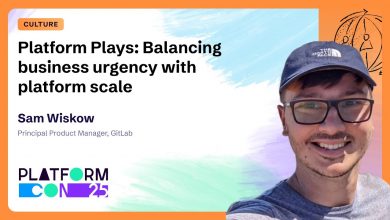Accelerating DevOps with DORA – Deutsche Bank
Learn from the 2021 Google Cloud DevOps Award winner, Deutsche Bank, on how they have been accelerating their DevOps with DORA principles.
 Learn from the 2021 Google Cloud DevOps Award winner, Deutsche Bank, on how they have been accelerating their DevOps with DORA principles.
Learn from the 2021 Google Cloud DevOps Award winner, Deutsche Bank, on how they have been accelerating their DevOps with DORA principles.
Leaders decided to introduce Google’s DORA framework, a benchmarking process based on data from more than 32,000 participants, to enable cultural change and to drive superior DevOps performance at the bank.
This required tailoring the DORA process for individual teams while still capturing divisional insights and developing an approach that met future use ambitions.
Objectives
The organization’s technology, data, and innovation objectives for DORA implementation revolved around cost reduction in multiple ways:
- Engineering capability – A previous strategy of outsourcing to contractors degraded internal practices and increased costs for the maintenance of legacy systems.
- Service stability – Availability and reliability are paramount to revenue generation in the bank’s key activities such as settling financial trades. Thousands of transactions occur every minute, so any period of instability or unavailability causes significant lost revenue.
- Regulatory compliance – System outages can prevent the bank from fulfilling its regulatory duties, such as reporting transaction data to government entities. Regulators have stringent requirements for both completeness and timeliness of this reporting and have imposed significant fines for lapses.
- Technology – The bank has a complex and costly IT estate. Duplicated functionality runs on expensive infrastructure with minimal automation and burdensome governance. The team sought to reduce risk, complexity, and cost while supporting innovation and growth.
Solution
Deutsche Bank’s technology organization executed DORA evaluations including 22 assessments across more than 90 teams and 1,700 respondents who collectively represented multiple billions of dollars in revenue generation for the bank.
The themes that emerged from those assessments pointed to the potential for the biggest improvements from adopting loosely coupled architecture, cloud services, and small, frequent code updates.
In partnership with Google Cloud, Deutsche Bank set out to accelerate its technology transformation. A more rapid transition to the cloud would enable the bank to improve resilience, deliver new capabilities to its customers quicker, and reduce cost over time.
DORA provided a common framework for implementing these improvements. The concepts are being rolled out top-down through Deutsche Bank’s engineering and architecture manifesto to provide shared vision, and bottom-up through grass-roots initiatives such as enhanced metric reporting and widespread rollout of the DORA capability assessment.
Under this program, the bank will migrate 1,400 core applications to the cloud over five years and is focused on increasing technical self-sufficiency and incorporating core practices such as stronger DevOps and SREs.
Results
Evidence of the impact has been striking. One early adopting team increased its release frequency by threefold and achieved a 40 percent reduction in incidents over the first three quarters of 2021.
Another team sped up deployment by 60 percent and reduced incidents by 9 percent. Adoption of DORA by two lines of business in the risk, finance, and treasury function yielded early cost savings of EUR 500,000.
Deutsche Bank has found that higher DORA performance scores correlate to faster release cycles, and these teams are affected by –and cause – fewer incidents.
Alignment with DORA is enabling the bank to undertake large changes while maintaining technical and compliance controls and achieving consistency and velocity in its DevOps practices. Deutsche Bank targets frictionless development so it can focus resources on innovation and new functionality.
Automation will underpin these efforts. Other benefits include streamlined workflows, reduced staff costs, stronger teamwork, and enhanced shared knowledge.
By 2025, the bank is targeting “high status” for critical applications including:
- Lead time of less than a day.
- Change failure of less than 15 percent.
- Cycle time of less than a day.
- On-demand deployment frequency.
- MTTR of less than an hour.



